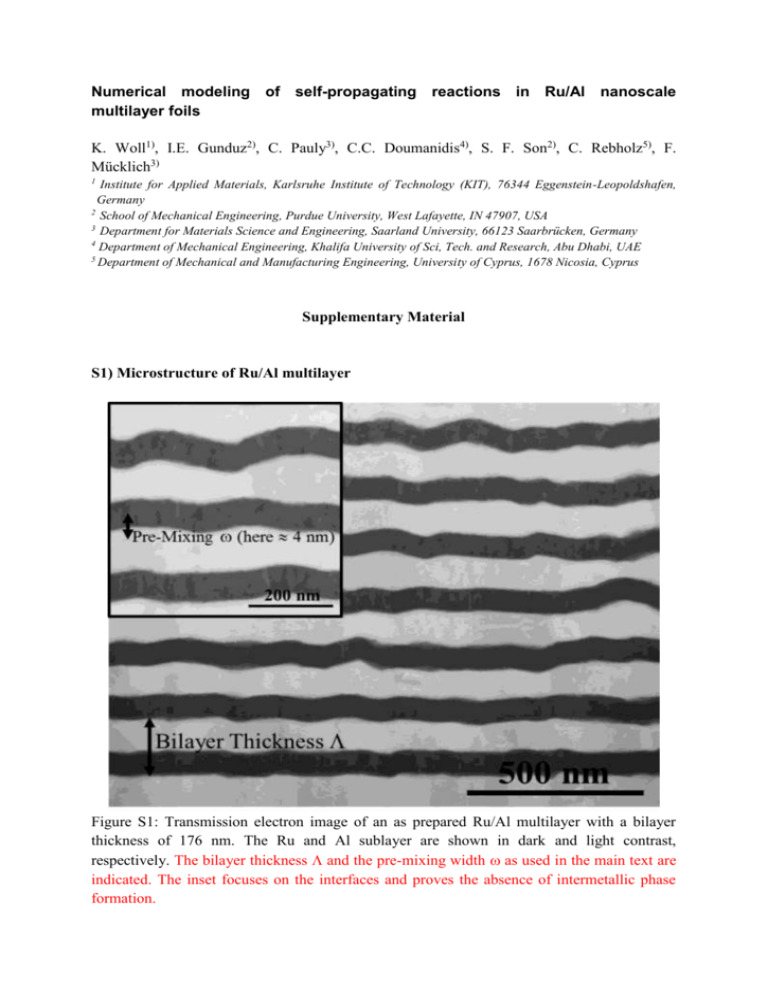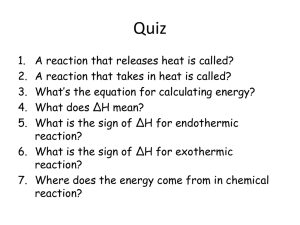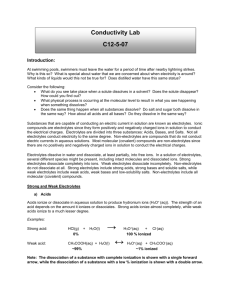Supplementary Material_revised
advertisement

Numerical modeling of self-propagating reactions in Ru/Al nanoscale multilayer foils K. Woll1), I.E. Gunduz2), C. Pauly3), C.C. Doumanidis4), S. F. Son2), C. Rebholz5), F. Mücklich3) 1 Institute for Applied Materials, Karlsruhe Institute of Technology (KIT), 76344 Eggenstein-Leopoldshafen, Germany 2 School of Mechanical Engineering, Purdue University, West Lafayette, IN 47907, USA 3 Department for Materials Science and Engineering, Saarland University, 66123 Saarbrücken, Germany 4 Department of Mechanical Engineering, Khalifa University of Sci, Tech. and Research, Abu Dhabi, UAE 5 Department of Mechanical and Manufacturing Engineering, University of Cyprus, 1678 Nicosia, Cyprus Supplementary Material S1) Microstructure of Ru/Al multilayer Figure S1: Transmission electron image of an as prepared Ru/Al multilayer with a bilayer thickness of 176 nm. The Ru and Al sublayer are shown in dark and light contrast, respectively. The bilayer thickness and the pre-mixing width as used in the main text are indicated. The inset focuses on the interfaces and proves the absence of intermetallic phase formation. S2) Thermal-physical properties of the elements and the Ru-Al phases TABLE SI: Densities and enthalpies of the individual phases Density Enthalpy Species (kg/m3) (J/mol) Aluminum * 2700 solid 2: -8282.5824 + 25.0307T + 4.410-3T2 - 8.980910-6T3 1 liquid 2: -795.991 + 31.7482T 1 Ruthenium 12450 RuAl 8286 3 solid 2: -8475.49 + 27,4688T – 1.110-3T2 – 1.34310-6T3 liquid 2: -17161.807 + 51.8816T solid 4,*: -69939.78 + 26.2551T + 1.6510-3T2 – 2.231910-9T3 According to the CALPHAD calculations by Prins et al., the first summand takes a value of -61939.78 J/mol 4. However, based on their data, the calculated value for the enthalpy of formation of RuAl is only -53000 J/mol. We added 8000 J/mol to achieve the experimentally found heat of formation of -62000 J/mol. TABLE SII: Enthalpy of melting and thermal conductivity of the individual phases Enthalpy of melting Species Thermal conductivity (W/mK) (J/mol) Aluminum 10711 2 -0.0398·T + 251.12 5 Ruthenium 38589 2 -0.019·T + 119.71 5 RuAl 63000 75 6 References 1. Haynes, W. M. ed., CRC- Handbook of Chemistry and Physics, 96th ed. (CRC Press/Taylor and Francis, Boca Raton, FL, 2015). 2. (SGTE), S. G. T. E., Franke, P. & Neuschütz, D., in Landolt-Börnstein - Group IV Physical Chemistry (Springer, 2012), Vol. 19B5. 3. Mücklich, F. & Ilic, N., RuAl and its alloys. Part I: structure, physical properties microstructure and processing (review). Intermetallics 13, 5-21 (2005). 4. Prins, S. N., Cornish, L. A., Stumpf, W. E. & Sundman, B. Calphad 27, 79-90 (2003). 5. Ho, C. Y., Powell, R. W. & Liley, P. E., Thermal Conductivity of the Elements. J. Phys. Chem. Ref. Data 1, 279-421 (1972). 6. Anderson, S. A. & Lang, S. I., Thermal Conductivity of Ruthenium Aluminide (RuAl). Scripta Mater 38 (3), 493-497 (1997).










